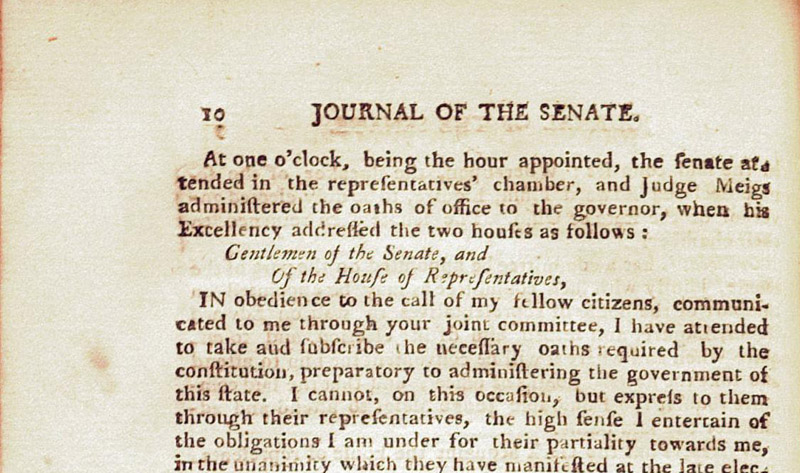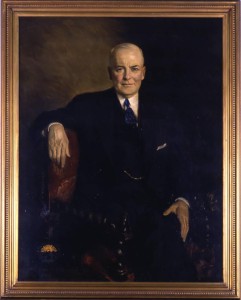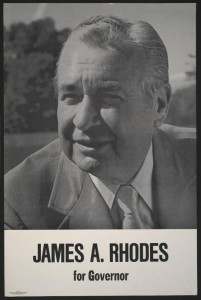State of the State: The Governor’s Annual Messages

On January 8, 1790, George Washington delivered the nation’s first State of the Union address. These annual speeches are mandated by the United States Constitution and, with few exceptions, have been given every January for 225 years. This year’s State of the Union, incidentally, is scheduled for January 12.
Since 1803, Ohio governors have similarly been addressing the General Assembly with speeches that are reflective of the time and climate in which they were given. These are written snapshots of the successes and concerns of the time and, though bipartisan in tone, are excellent resources for researchers in many areas. Like the president, Ohio governors are mandated by the Constitution – in this case, the Ohio Constitution – to “communicate at every session, by message, to the General Assembly, the condition of the State, and recommend such measures as he shall deem expedient” (Article 3, Section 7).

The majority of Ohio governors’ State of the State addresses can be found in Ohio Memory, both in the Ohio Governor’s Collection and in the Ohio State of the State Addresses collection. Reading them shows us that some speeches continue to resonate strongly, such as that of Governor George White in 1935 as he spoke of the Great Depression: “While recovery is unquestionably under way, its effect will not be reflected in any great immediate reduction of those on relief… until such time as industry shall have further revived…. It is my opinion that you are safe in assuming that the financial burden will be as great and possible greater than in 1934.” Our recent financial woes, dubbed the Great Recession, bore this out, despite White’s words having been written 74 years prior. Similarly, the 1961 address of Governor Michael DiSalle included this plea, the result of a period of severe unemployment: “I urge you not to delay the extension of unemployment benefits for an additional thirteen weeks… for it is needed and many people are in a period of distress not of their own making.” DiSalle also said these wise words, worthy of bearing in mind today, in the same address: “We must never confuse unity of purpose with unanimity of opinion….”

Addresses are not just filled with doom and dire warnings, however. The 1957 address given by Governor William O’Neill speaks of remarkable growth, with the creation of a “giant wave of activity” from Conneaut to Toledo, thanks to the St. Lawrence Seaway and the addition of new factories “almost daily” in the Ohio River Valley. “It is often reported,” he says, “that Columbus and Central Ohio are the fastest growing areas in the country.” Governor James Rhodes’ 1967 address was even more positive: “[Ohio’s] goals are the highest. Ohio’s potential is the greatest. We start on a sound base.” And, finally, Governor John Kasich’s words from his most recent (as of this writing) State of the State address in 2015: “The sun is coming up in Ohio, but it’s not reached its zenith. It’s not in that cloudless blue sky shining for everyone to see. But we can push it there. We can help it to get there if we do it together.”
These addresses remind us that there are no new challenges, only new people to solve them. And though only 95 years of addresses have been digitized and added to Ohio Memory, more are being added regularly. We are certain that, if you spend a few moments with these pieces of history, you’ll find words that resonate with you, too.
Thank you to Shannon Kupfer, Digital/Tangible Media Cataloger at theState Library of Ohio, for this week’s post!



Leave a Reply
You must be logged in to post a comment.